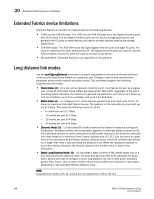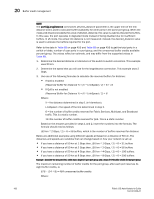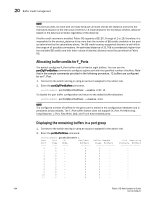HP StorageWorks 1606 Brocade Fabric OS Administrator's Guide v6.3.0 (53-100133 - Page 492
Optimal buffer credit allocation, Considerations for calculating buffer credits
 |
View all HP StorageWorks 1606 manuals
Add to My Manuals
Save this manual to your list of manuals |
Page 492 highlights
20 Buffer credit management Optimal buffer credit allocation The optimal number of buffer credits is determined by the distance (frame delivery time), the processing time at the receiving port, link signaling rate, and the size of the frames being transmitted. As the link speed increases, the frame transmission time is reduced and the number of buffer credits must be increased to obtain full link utilization, even in a short-distance environment. For each frame that is transferred, the hardware at the other end must acknowledge that the frame has been received before a successful transmission occurs. This requires enough capacity in the hardware to allow continuous transmission of frames on the link, while waiting for the acknowledgement to be sent by the receiver at the other end. As the distance between switches and the link speed increases, additional buffer credits are required for the ports used for long-distance connections. Distance levels define how buffer credits are allocated and managed for extended ISLs. Buffer credits are managed from a common pool available to a group of ports on a switch. The buffer credit can be changed for specific applications or operating environments, but it must be in agreement among all switches to allow formation of the fabric. To maintain 100 percent utilization of a 1 Gbps link for 100 km, the sending hardware must have enough resources (BB credits) to keep 106,250 bytes on the link and the receiving hardware must have enough resources to allow the sender to transmit continuously. To theoretically achieve 100 percent utilization of a 1 Gbps link for 100 km, the required number of BB credits ranges from 49 to 1155 depending on the average frame size. When the link speed is increased to 2 Gbps, the required number of BB credits ranges from 98 to 2310. It is not possible for the switch to determine what the frame size is going to be. Considerations for calculating buffer credits Following are the considerations for calculating how many ports can be configured for long distance on all Fabric OS v6.x capable switch modules: • Each port is part of a port group that includes a pool of buffer credits that can be utilized. This is not the same as the port groups used for ISL Trunking. • Each user port reserves eight buffer credits when online or offline. • Any remaining buffers can be reserved by any port in the port group. • When QoS is enabled and the port is online, an additional 14 buffers are allocated to that port. • The following switches and blades have a limitation of 255 buffers maximum that can be allocated to a port, which corresponds to a distance of ~500 km at 1 Gbps: 4100, 4900, 5000, 7500, 7600 FA4-18, FC4-16IP, FR4-18i FC4-16, FC4-32, FC4-48 NOTE The following switches and blades do not have this limitation: 300, 5100, 5300, 5410, 5424, 5450, 5480, FC8-16, FC8-32, FC8-48. 450 Fabric OS Administrator's Guide 53-1001336-01















